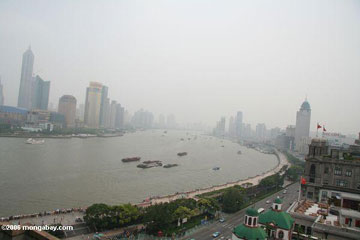Can China Go and Stay Green?
Can China Go and Stay Green?
mongabay.com
January 3, 2008
|
|
China’s booming economic growth over the past generation has come at the expense of the environment, putting its economic health at risk, argues a policy piece published in the journal Science.
Noting that two-thirds of China’s cities face water shortages and 16 of the world’s 20 most polluted cities are found within its borders, Jianguo Liu and Jared Diamond argue that while China has set ambitious environmental goals, it has consistently fallen short of meeting them. Liu and Diamond say a major problem is that environmental decisions are made at the national level, but are not enforced by provincial and city leaders, who are unwilling to sacrifice economic growth for environmental gains. This single-minded pursuit of rapid growth will continue to undermine environmental efforts unless China begins to “weight environmental performance equal to economic performance,” say the authors.
To do this, Liu and Diamond suggest the creation of a “high-level, authoritative national organization that coordinates all relevant ministries and agencies for economic development and environmental protection.” Progress should be measured by “Green GDP” — an economic indicator where economic costs of environmental impact and ecological destruction are subtracted from traditional GDP — rather than traditional GDP. The authors also propose other measures to “shift China’s economic development model toward high efficiency and low pollution,” including “investment in environmentally friendly enterprises, reform of land ownership, loans with low interest rates to those enterprises, taxes on polluting enterprises, and eco-compensation (payments to those protecting environmentally sensitive areas), … green insurance (insurance companies cover the cost of environmental damage and push for better environmental protection),” they write.
 Shanghai’s air quality has worsened in 2007 according to SEPA. |
“Developing more environmentally friendly technologies for domestic use and export would increase employment and economic efficiency while reducing environmental damage,” Liu and Diamond continue. “Changing the development model requires changes in attitudes toward the environment. Many people still hope that the path followed by developed countries (pollute first, control later) will work for China, but that hope is risky because China suffers from two new disadvantages: Natural resources are more limited today, and fewer countries accept pollution transfers. Even if pollution can be controlled.”
“Environmental protection should be treated as an integral part of sustainable economic development. Because humans and the environment are coupled systems, there are complex interactions and feedback between humans and the environment, and negative impacts may not show up until decades later.”
Liu and Diamond say that foreign firms invested in China should help the country in its efforts to become a greener nation. Some environmentalists argue that by moving production and manufacturing to China, foreign firms are effectively outsourcing carbon dioxide emissions and pollution to the country. Further, by demanding ever lower prices for goods, foreign firms are driving Chinese manufacturers to cut costs by skirting health and environmental regulations.
China became the world’s largest emitter of CO2 in 2006 according to analysis by the Netherlands Environmental Assessment Agency (EEA), a group that advises the Dutch government. China produced 6,200 million metric tons of carbon dioxide that year, compared with 5,800 million tons for U.S. CO2 emissions in China are now 7.5 percent higher than in America, whereas in 2005 China’s emissions lagged 2 percent behind those of the U.S., which faces a slowing economy.
CITATION: Liu, J and Diamond, J (2007). “Revolutionizing China’s Environmental Protection,” 04 JANUARY 2008 VOL 319 SCIENCE